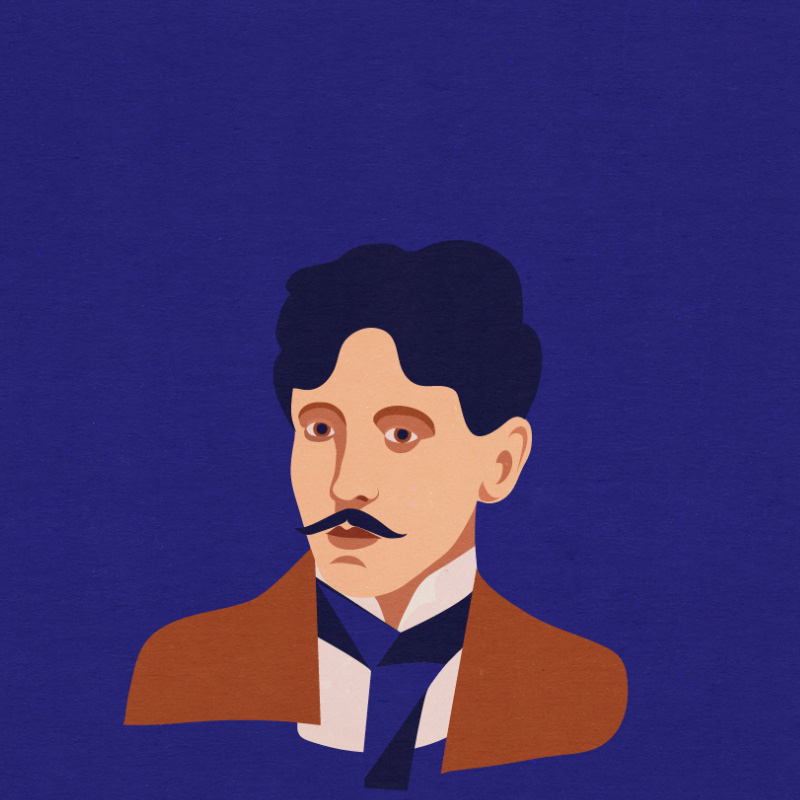Mikalojus Konstantinas Čiurlionis – the Most Famous Unrecognised Genius of Lithuania?
> BACK TO 100 STORIESThe most famous unrecognised genius – sounds strange, doesn't it? However, the case of the nineteenth-century Lithuanian composer and artist Mikalojus Konstantinas Čiurlionis (1875–1911) is sometimes considered to be exactly that. Čiurlionis was the first professional composer to create symphonic and chamber music in Lithuania, and his symbolic paintings gave rise to modern Lithuanian art. His work is unique as it combines the elements of music and art: wavy lines and layered colours in his paintings create the impression of rhythm, and while listening to his musical compositions you see images and paintings of stormy seas or sunlit forest clearings. Of course, Čiurlionis’ fame is not limited to Lithuania. His paintings are on display at exhibitions in St. Petersburg, Moscow, Riga, Kiev and Paris. Even nowadays the genius from Lithuania still receives attention – in 2013, 180 paintings by Čiurlionis went on display at the Museum of Fine Arts Ghent in Belgium, as well as in an exhibition at the Musée d'Orsay in Paris. Nevertheless, art historians wonder why this Lithuanian who left a special mark on music and art didn’t receive greater international recognition and didn’t become a Lithuanian Salvador Dali?
This was probably due to his early death (he died aged thirty-six) and the fact that he was from Lithuania, a small country where artistic movements did not dictate fashions, but followed foreign influences. It is obvious that Čiurlionis felt the same – as soon as the opportunity came up, he went to study abroad. He received financial support from Duke Mykolas Oginskis and studied music at the Warsaw and Leipzig Conservatories. He got interested in painting quite late and then studied it at the Warsaw School of Art. Although he belonged to the Lithuanian Society of Art and was invited to participate in exhibitions and even organised them, in 1908 he moved to St. Petersburg, which was experiencing an artistic upheaval at the time. Of course, Čiurlionis expected international recognition, but the competition of local artists was intense and the talented newcomer didn’t receive much attention. However, he achieved what he wanted – at least in part: he was admitted to the Union of Russian Artists, visited fashionable salons, and his paintings were exposed at important exhibitions. It was in St. Petersburg that Čiurlionis painted one of his most famous paintings, Rex [Latin for King]. It depicts the symbolic ruler of the universe rising above planet Earth. This is the essence of Symbolist art: symbols which convey the images and ideas of the spiritual world, not the reproduction of real objects.
Čiurlionis’ music is at the foundation of Lithuanian classical music and was an inspiration for later composers. The most popular works by Čiurlionis are the symphonic poems In the Forest and The Sea. His most ambitious and innovative project was the opera Jūratė, which he planned to create with his wife Sofija Kymantaitė. Unfortunately, the opera could not be completed – only some fragments of it remained: a libretto (the text used in opera) written by Kymantaitė and decorations designed by Čiurlionis. Musicologists say that this opera would have marked the beginning of a new era in the symbolism of the composer’s music, where music and the visual arts would have merged.
Although Čiurlionis’ international recognition could be greater, his significance and influence keeps growing over time – his work is arguably not aging, but becoming more modern. The Lithuanian film director Kristina Buožytė presented a short virtual reality project-film Trail of Angels at the Venice Film Festival in 2018. According to the author, this is a tribute to Čiurlionis, the forerunner of multimedia art, which combines music and painting, and one of the pioneers of abstract art in Europe.

